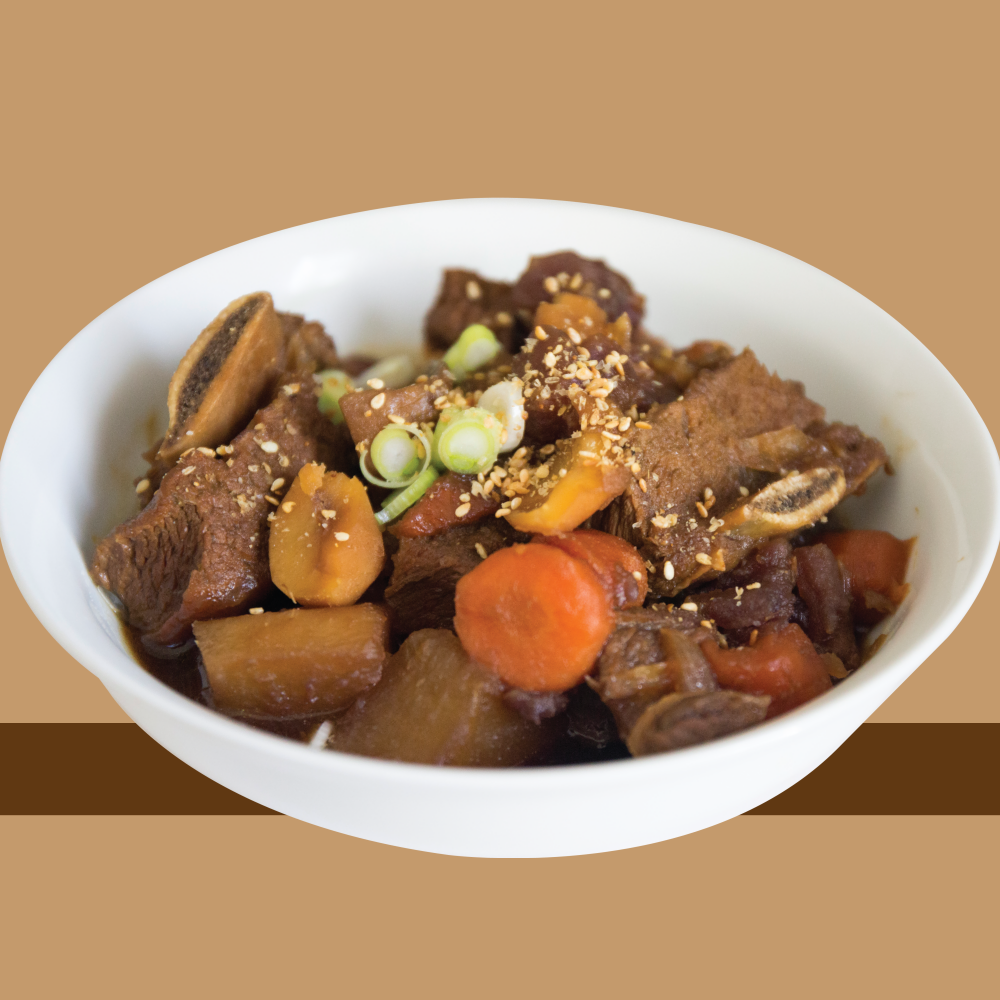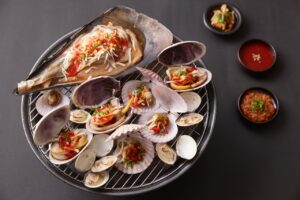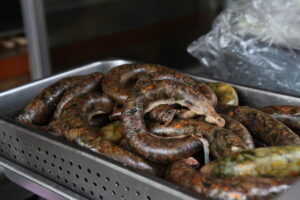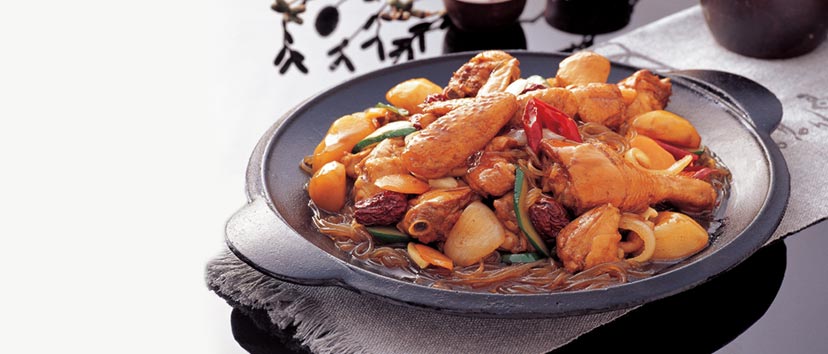
Do you know Jjimdak?
“Jjimdak” (찜닭) is a popular Korean dish that consists of braised chicken and various vegetables cooked in a flavorful and slightly spicy sauce. The name “jjim” refers to the braising cooking method, and “dak” means chicken in Korean. Jjimdak is known for its tender and succulent chicken pieces, along with the savory and slightly sweet taste of the sauce.
Here’s more about Jjimdak:
Jjimdak Recipe
Ingredients:
The main components of Jjimdak include:
Chicken: Typically bone-in chicken pieces, often a combination of white and dark meat.
Vegetables: Common vegetables used include potatoes, carrots, onions, and sweet potatoes.
Sauce: The sauce for Jijmdak is made from a mixture of soy sauce, sugar, garlic, ginger, sesame oil, and Korean chili paste (gochujang). It’s a balance of savory, slightly sweet, and spicy flavors.
Preparation and Cooking:
Here’s how It is typically prepared:
Preparation: The chicken pieces are usually cut into smaller portions, and the vegetables are also cut into bite-sized pieces. This allows for even cooking and better absorption of the flavors.
Sautéing: The chicken and vegetables are briefly sautéed in a pot or a wide pan to develop some color on the exterior.
Sauce and Braising: The sauce mixture is added to the pot, along with some water. The dish is then braised over medium heat, allowing the chicken and vegetables to absorb the flavors of the sauce.
Simmering: The pot is covered, and the dish simmers until the chicken becomes tender and the vegetables are cooked through. This slow cooking process allows the flavors to meld together.
Serving: Once cooked, It is served in the pot it was cooked in. It’s often garnished with chopped green onions and sesame seeds. Some variations also include chewy sweet potato noodles (dangmyeon) added to the dish.
Variations:
While the classic version of this features chicken and vegetables, there are also variations that incorporate other ingredients like mushrooms, seafood, or additional seasonings for different flavor profiles.
Serving and Accompaniments:
It is commonly enjoyed as a shared dish in a group setting. It’s often served with a side of rice to balance the flavors and provide a filling meal. The sauce-soaked vegetables and tender chicken are flavorful and satisfying, making it a popular choice in Korean restaurants.
Overall, this is a comforting and hearty dish that combines the comforting flavors of braised chicken with the richness of the sauce and the textures of the vegetables.
Jjimdak famous place in south Korea
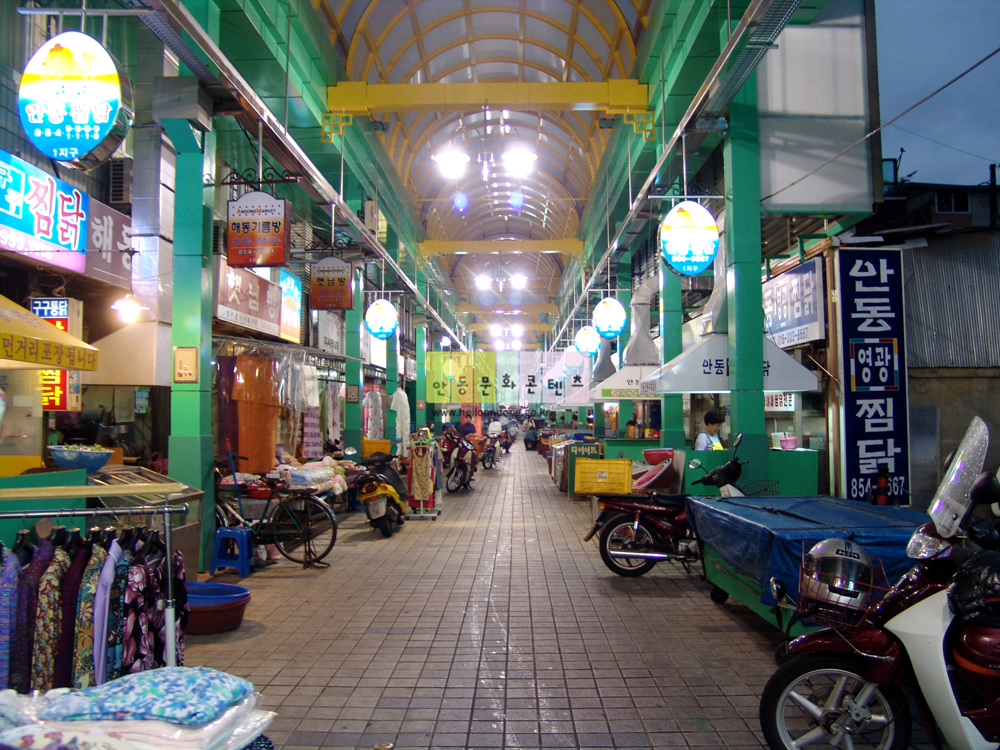
This is a popular Korean dish that can be found in various regions throughout South Korea. However, there are certain areas that are particularly well-known for their delicious and unique variations of Jjimdak. Here are a few places in South Korea that are famous for their Jjimdak:
Andong (안동): Andong-Jjimdak is one of the most famous regional variations of the dish. Andong is a city in Gyeongsangbuk-do Province known for its rich culinary heritage. Andong-Jjimdak is characterized by its slightly sweet and savory sauce, along with a combination of chicken, various vegetables, and glass noodles (dangmyeon). It’s a must-try dish if you’re in the Andong area.
Cheonan (천안): Cheonan, located in South Chungcheong Province, is another city known for its Jjimdak. Cheonan Jjimdak is often referred to as “chijeu Jjimdak,” where “chijeu” means “cheese” in Korean. This variation includes cheese as a topping, adding a creamy and indulgent element to the dish.
Seoul: As the capital city of South Korea, Seoul offers a wide variety of options from different regions. You can find restaurants and eateries that serve both traditional and modern variations. Some areas in Seoul, like the neighborhood of Sindang-dong, are particularly famous for their Jjimdak offerings.
Busan: Busan, a coastal city, has its own take on it with a seafood twist. Busan Jjimdak often includes ingredients like squid, shrimp, and mussels, in addition to chicken and vegetables. The seafood adds a unique flavor profile to the dish.
Incheon: Incheon, another major city in South Korea, has its own style of Jjimdak that is worth trying. Incheon-Jjimdak may have a milder flavor compared to other variations, appealing to those who prefer less-spicy dishes.
These are just a few examples of places where Jjimdak is famous in South Korea. Each region may have its own interpretation of the dish, incorporating local flavors and ingredients. If you’re traveling through South Korea, be sure to explore these regional variations of Jjimdak to experience the diversity of Korean cuisine.
Spicy chicken dish
Jjimdak, a Korean braised chicken dish, is not traditionally very spicy. The primary flavor profile of Jjimdak is savory and slightly sweet, with the potential to have a hint of spiciness depending on the recipe and personal preferences. While there are variations of Jjimdak that include spicy elements, the dish as a whole is not inherently known for its spiciness.
The primary factors that contribute to the spiciness of a particular dish include:
Gochugaru (Korean Red Pepper Flakes): Some recipes may include a small amount of gochugaru, which is Korean red pepper flakes. Gochugaru is commonly used in Korean cuisine to add heat and flavor to dishes. Depending on the quantity used, it can introduce a mild to moderate level of spiciness.
Gochujang (Korean Red Pepper Paste): Gochujang is another staple in Korean cooking and is made from fermented soybeans and red pepper. It can be used to add depth of flavor and a subtle spiciness to Jjimdak.
Personal Preferences: Some people enjoy adding extra gochugaru or gochujang to their Jjimdak to make it spicier. This is a matter of personal taste, and the level of spiciness can be adjusted according to individual preferences.
Regional Variations: As with many Korean dishes, there can be regional variations of Jjimdak that differ in flavor and spice levels. Some regions might have a preference for spicier Jjimdak, while others may emphasize other flavor elements.
It’s important to note that the majority of Jjimdak recipes do not include high levels of spiciness, and many versions of the dish focus more on the balance between savory, sweet, and umami flavors. If you prefer a less spicy version of Jjimdak, you can look for recipes that use minimal or no gochugaru or gochujang, or you can adjust the spice levels according to your taste.
What is similar food with Jjimdak in the world?
Jjimdak, the Korean braised chicken dish, shares some similarities with dishes from various cuisines around the world. While the exact combination of flavors and ingredients may differ, the concept of slow-cooking meat with vegetables and flavorful sauces is a common culinary practice in many cultures. Here are a few dishes that share similarities with Jjimdak:
Chicken Cacciatore (Italy): Chicken Cacciatore is an Italian dish that involves braising chicken in a tomato-based sauce with onions, bell peppers, mushrooms, and herbs. The slow-cooking process allows the flavors to meld together, resulting in a rich and comforting dish.
Coq au Vin (France): Coq au Vin is a classic French dish in which chicken is braised with red wine, mushrooms, onions, and bacon. The long cooking time allows the chicken to become tender and absorb the flavors of the wine and other ingredients.
Adobo (Philippines): Filipino Adobo is a dish where meat, often chicken, is marinated and braised in a mixture of vinegar, soy sauce, garlic, and other spices. The braising process infuses the meat with a savory and slightly tangy flavor.
Tajine (Morocco): Tajine is a North African dish cooked in a special clay pot of the same name. The dish typically includes meat, such as chicken, along with vegetables, dried fruits, and a blend of aromatic spices. It’s slow-cooked to create tender and flavorful results.
Hainanese Chicken Rice (Singapore/Malaysia): While not a braised dish, Hainanese Chicken Rice involves poaching chicken in a flavorful broth and serving it with fragrant rice and various condiments. The focus on tender chicken and complementary flavors is reminiscent of Jjimdak.
Rendang (Indonesia/Malaysia): Rendang is a slow-cooked dish originating from Indonesia and Malaysia. It involves simmering meat, often beef, in a mixture of coconut milk and spices until the liquid is reduced and the meat becomes tender. The dish is deeply flavorful and aromatic.
Shawarma (Middle East): While not braised, shawarma involves marinating and slow-cooking meat on a vertical rotisserie. The cooked meat is shaved off and often served in flatbreads with vegetables and sauces, creating a savory and hearty meal.
While these dishes may not be identical to Jjimdak, they showcase the global appeal of slow-cooked meats combined with flavorful sauces and complementary ingredients. Each dish reflects the culinary traditions and preferences of its respective region.

Andong-Jjimdak, Seoul Myeog-dong
Restaurant name : Andong-Jjimdak
Address : Myeong-dong 2ga, 2-2 Seoul South Korea
Tel : +82-02-310-9174
